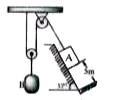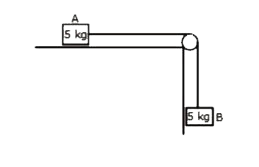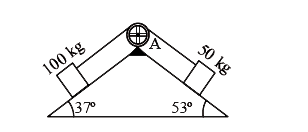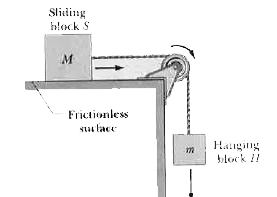A block of mass 3 kg which is on a smooth inclined plane making an angle of 30° to the horizontal is connected by a cord passing over a light frictionless pulley to a second block of mass 2 kg hanging vertically. What is the acceleration of each block and what is the tension of the cord?Solution in Telugu
0.98m/s2,17.6N
1.98m/s2,19.6N
0.49m/s2,9.8N
1.47m/s2,4.9N
The correct Answer is:A
Step by step video, text & image solution for A block of mass 3 kg which is on a smooth inclined plane making an angle of 30° to the horizontal is connected by a cord passing over a light frictionless pulley to a second block of mass 2 kg hanging vertically. What is the acceleration of each block and what is the tension of the cord? by Physics experts to help you in doubts & scoring excellent marks in Class 11 exams.
Updated on:21/07/2023Topper's Solved these Questions
- NEWTONS LAWS OF MOTION Book:AAKASH SERIESChapter:NEWTONS LAWS OF MOTION Exercise:PRACTICE SHEET (EXERCISE - II) (LEVEL - II) (Straight Objective Type Questions)
Explore 7 Videos
- NEWTONS LAWS OF MOTION Book:AAKASH SERIESChapter:NEWTONS LAWS OF MOTION Exercise:PRACTICE SHEET (EXERCISE - II) (LEVEL - II) ( More than one correct answer Type Questions )
Explore 4 Videos
- NEWTONS LAWS OF MOTION Book:AAKASH SERIESChapter:NEWTONS LAWS OF MOTION Exercise:PRACTICE SHEET (EXERCISE - I) (LEVEL - II) (Matrix Matching Type Questions)
Explore 1 Video
- MOTION IN A STRAIGHT LINEBook:AAKASH SERIESChapter:MOTION IN A STRAIGHT LINEExercise:Questions for Descriptive Answers
Explore 7 Videos
- OSCILLATIONBook:AAKASH SERIESChapter:OSCILLATIONExercise:QUESTIONS FOR DESCRIPTIVE ANSWERS
Explore 12 Videos
Similar Questions
The blocks A and B shown in the figure have masses MA=5kgandMB=4kg. The system is released from rest. The speed of B after A has travelled a distance 1 m along the incline is

View SolutionThere are two blocks A and B in contact with vertical and horizontal smooth surface respectively Acceleration of A and B are aaandaB respectively along their constrained direction of motions. Relation between aAandaB is (Assume sin 230=25 )

View SolutionMatch the two colums : Column - I indicates a situation & Column - II indicates the fundamental forces in physics
Column - IColumn -IIA) Force between two protonsP) Gravitational forceB) force between two neutronsQ) electromagnetic forceC) force between pen and fingerR) Strong nuclear forceD) Tension force in string S) Weak nuclear force
View SolutionThree tortoises are located at the vertices of an equilateral triangle whose side equals a They all start moving simultaneously with velocity v constant in modulus with the first tortoise heading continually for the second , the second for the third and the third for the first . They will meet after time
View SolutionThe spring shown in figure is unstretched when a man starts pulling on the cord. The mass of the block is M. If the man exerts a constant force F, find the amplitude and the time period of the motion of the block.

View SolutionA 4 kg block is on a smooth horizontal table. The block is connected to a second block of mass 1 kg by a massless flexible taut cord that passes over a frictionless pulley. The 1 kg block is 1m above the floor. The two block are released from rest. With what speed does the 1 kg block hit the ground? .
View SolutionA block of mass 3kg which is on a smooth inclined plane making angie of 30^(@) to the horizontal is connected by cord passing over light frictionless pulley to second block of mass 2kg hanging vertically. What is the acceleration of each block and waht is the tension of the cord ? .
View SolutionA block of mass M_(1)=3kg on a smooth fixed inclined plane of angle 30^(@) is connected by a cord over a small frictionless pulley to a second block mass 2kg hanging vertically. The tension in the cord and the acceleration of each block are ………............. and ...................... respectively.
View SolutionA block of mass 5 kg resting on a horizontal surface is connected by a cord, passing over a light frictionless pulley to a hanging block of mass 5 kg. The coefficient of kinetic friction between the block and surface is 0.5. Tension in the cord is (take, g=9.8ms^(-2) )
View SolutionA block of mass 5 kg resting on a horizontal surface is connected by a cord, passing over a light frictionless pulley to a hanging block of mass 5 kg. The coefficient of kinetic friction between the block and the surface is 0.5. Tension in the cord is (g=9.8m/s2 )

View SolutionA block of mass m_(1) =2 kg on a smooth inclined planeat angle 30^(@) is connected to a second block of mass m_(2) =3kg by a cord passing over a frictionless pulley as shown in figure. The acceleration of each block is - (Assume g = 10 m//sec^(2) )
View SolutionTwo blocks are connected by a cord passing over a small frictionless pulley and resting on frictionless planes as shown in the figure. The acceleration of the blocks is :

View SolutionA block of mass 3kg which is on a smooth inclined plane making an angie of 30∘ to the horizontal is connected by cord passing over light frictionless pulley to second block of mass 2kg hanging vertically. What is the acceleration of each block and what is the tension of the cord ?
View SolutionFigure 5-20 shows a block S (the sliding block) with mass M = 3.3 kg. The block is free to move along a horizontal frictionless surface and connected, by a cord that wraps over a frictionless pulley, to a second block H (the hanging block), with mass m = 2.1 kg. The cord and pulley have negligible masses compared to the blocks (they are "massless"). The hanging block H falls as the sliding block S accelerates to the right. Find (a) the acceleration of block S, (b) the acceleration of block H, and ( c ) the tension in the cord.

Figure 5.20 A block S of mass M is connected to a block H of mass m by a cord that wraps over a pulley.
View SolutionA block of mass m_(1)=3.70 kg on a frictionless plane inclined at angle 30.0^(@) is connected by a cord over a massless, frictionless pulley to a second block of mass m_(2)=2.30 kg (see Fig. 5-32). (a) What is the magnitude of the acceleration of each block? (b) What is the direction of the acceleration of the hanging block ? (c) What is the tension in the cord?
View Solution

